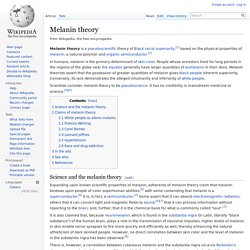

Dr Llaila Afrika.
Neuromelanin, neurotransmitter status and brainstem location determine the differential vulnerability of catecholaminergic neurons to mitochondrial DNA deletions. Pineal gland. The pineal gland, also known as the pineal body, conarium or epiphysis cerebri, is a small endocrine gland in the vertebrate brain.

It produces melatonin, a serotonin derived hormone, which affects the modulation of sleep patterns in both seasonal and circadian rhythms.[1][2] Its shape resembles a tiny pine cone (hence its name), and it is located in the epithalamus, near the center of the brain, between the two hemispheres, tucked in a groove where the two halves of the thalamus join. Nearly all vertebrate species possess a pineal gland. The gland has been compared to the photoreceptive, so-called third parietal eye present in the epithalamus of some animal species, which is also called the pineal eye. René Descartes believed the pineal gland to be the "principal seat of the soul" and viewed it as the third eye.[6] Structure[edit] Blood supply[edit] Innervation[edit] The pineal gland receives a sympathetic innervation from the superior cervical ganglion.
Histology[edit] Development[edit] Melanin. Melanin theory. Melanin theory is a pseudoscientific theory of Black racial superiority,[1] based on the physical properties of melanin, a natural polymer and organic semiconductor.[2] In humans, melanin is the primary determinant of skin color.

People whose ancestors lived for long periods in the regions of the globe near the equator generally have larger quantities of eumelanin in their skins. Melanin theorists assert that the possession of greater quantities of melanin gives black people inherent superiority. Conversely, its lack demonstrates the alleged inhumanity and inferiority of white people. Scientists consider melanin theory to be pseudoscience.
Science and the melanin theory[edit] There is, however, a correlation between cutaneous melanin and the substantia nigra vis-a-vis Parkinson's disease, a neurological disease condition in which there is a loss of melanin-pigmented cells of the substantia nigra. Claims of melanin theory[edit] White people as albino mutants[edit] Frances Welsing[edit] Melanin, Afrocentricity, and Pseudoscience. Ortizde Montellanol showed affinities with tropical African patterns and differed notably from theMaghreb pattern.

Archaeological evidence suggests that the Nile valley was pri-marily settled by immigrants from both the Sahara and from more southern areasand that Egyptian culture was formed by the fusion of Saharan and Nilotic peoples(Hassan, 1988). The mixture of phenotypes suggested by the archaeological andskeletal evidence is amply supported by representations in art and sculpture (Ver-coutter, 1978; O’Connor, 1971; “rigger, 1978; Kelly, 1991). Et al. offer fur-ther review of Egyptian biological status (this volume). A multiracialsociety that did not discriminate internally on the basis of color, but looked downon all foreigners regardless of color (Yurco, 1989,1990; Snowden, 1970,1989,1992;Young, 1992; Levine, 1992; Coleman, 1992). Racially mixed society with. Dr. Jewel Pookrum - 7 Circuits Of The Brain. Melanin & Your Pineal Gland.